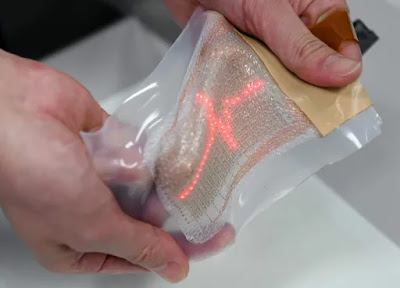Scientists have developed an ultrathin elastic display that fits snugly on the skin and can show the vital signs of the body recorded by an integrated sensor. Combined with a wireless communication module, this integrated biomedical sensor system, called "skin electronics," can transmit biometric data to the cloud.
Thanks to advances in semiconductor technology, wearable devices can now monitor health by measuring vital signs or taking an electrocardiogram, and then transmitting the data wirelessly to a smartphone. The readings or electrocardiogram waveforms can be displayed on the screen in real time, or sent to the cloud or a memory device where the information is stored. The newly developed skin electronics system goes a step further by enhancing information accessibility for people such as the elderly or the infirm, who tend to have difficulty operating and obtaining data from existing devices and interfaces.
It promises to ease the strain on home healthcare systems in aging societies through continuous, non-invasive health monitoring and self-care at home. The new integrated system combines a flexible, deformable display with a lightweight sensor composed of a breathable nanomesh electrode and wireless communication module. Medical data measured by the sensor, such as an electrocardiogram, can either be sent wirelessly to a smartphone for viewing or to the cloud for storage. In the latest research, the display showed a moving electrocardiogram waveform that was stored in memory.
The skin display consists of a 16x24 array of micro LEDs and stretchable wiring mounted on a rubber sheet. "Our skin display exhibits simple graphics with motion. Because it is made from thin and soft materials, it can be deformed freely," said Takao Someya at the University of Tokyo in Japan. The display is stretchable by as much as 45 per cent of its original length.
It is far more resistant to the wear and tear of stretching than previous wearable displays. It is built on a novel structure that minimises the stress resulting from stretching on the juncture of hard materials, such as the micro LEDs, and soft materials, like the elastic wiring - a leading cause of damage for other models. It is the first stretchable display to achieve superior durability and stability in air, such that not a single pixel failed in the matrix-type display while attached snugly onto the skin and continuously subjected to the stretching and contracting motion of the body.
The nanomesh skin sensor can be worn on the skin continuously for a week without causing any inflammation. Although this sensor, developed in an earlier study, was capable of measuring temperature, pressure and myoelectricity (the electrical properties of muscle), it successfully recorded an electrocardiogram for the first time in the latest research.










No comments:
Post a Comment